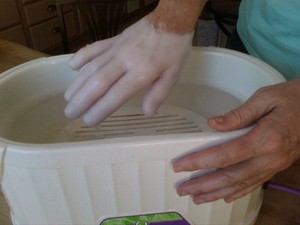Pain relief does not always need to come from prescriptions or over-the-counter drugs or homeopathic orally ingested preparations. Accidental overdoses and allergic reactions are deadly possibilities with each of those options.
Get Doctor’s Approval for Paraffin Therapy for Pain Relief
Paraffin therapy temporarily relieves pain associated with many conditions. It is often recommended by orthopedists, rheumatologists, and physical therapists to aid in pain relief and improving blood circulation in certain conditions. Paraffin therapy should only be used with approval and recommendation of a medical specialist who is familiar with the particular medical issue and patient. Some health insurance benefits may help with costs, so check coverage options before paying.
If a medical professional recommends paraffin therapy for a patient’s condition, such as for certain types of arthritis, and related illnesses, sports injuries older than 36 hours, and other specific diagnoses, it is important to use paraffin therapy properly to get the full benefit.
Steps to Use Paraffin Bath
Thoroughly wash and dry the hand or foot that is to be immersed, to keep the paraffin clean as possible for re-use and less waste.
Rub a thin layer of unscented moisturizing lotion on the area, to make the paraffin easier to remove from the skin and maintain the skin’s moisture during the paraffin heat therapy.
Slowly dip hand or foot into the paraffin, immersing it completely to cover the painful area.
Keep the fingers or toes as still as possible, so the paraffin can conform properly to the skin.
Slowly lift hand or foot from the paraffin, counting to 4 or 5 so the paraffin layer can set and wax stops dripping.
Continue dipping hand or foot until a thick glove of wax forms, about 5 to 8 times. The more layers are dipped the longer the heat will be maintained.
Carefully put waxed hand or foot into the plastic bag, laying bag closed around wrist or ankle.
Wrap towel around plastic bag, or put hand in a paraffin mitt, to hold the heat in.
Keep wax on for 15 to 20 minutes, or until it cools.
Remove towel (paraffin mitt) and plastic bag.
Peel off wax and return it to the paraffin container.
For facial, knee, elbow use, a clean paint brush can be used to apply layers of paraffin to the painful headache or joint area.
Paraffin Recycling and Reusing
When paraffin is used at a spa or physical therapy center, the wax must be disposed of for health code purposes. In home use, the user may choose to re-use the paraffin, especially if the person keeps a habit of washing the paraffin-dipped body part beforehand to help keep extraneous matter out of the paraffin.
After about 40 uses, the paraffin wax should be allowed to harden and the dry skin that has fallen to the bottom of the container can be scraped off the hardened wax. The clean remaining wax can be re-melted to 125 degrees Fahrenheit and paraffin added one pound at a time, along with 1/3 cup of mineral oil, food-grade almond oil, or Sicilian extra-virgin olive oil to replace the scraped-off wax.
Paraffin Baths: To Make One, Buy One, or Get Treatments by Appointment
When using a paraffin bath for pain therapy, it is most beneficial to have one at home. When the pain hits, it is ready to use day or night. Unlike a pill, it can be used anytime, and the bath belongs to you whether you made it or bought it.
If you rely on a beauty spa or a physical therapy center for paraffin treatments, the cost never ends. Each visit is another fee. Plus the treatment cannot happen spontaneously with your pain needs. Appointments must be scheduled in advance.
For further reading on buying paraffin spas, see Paraffin Baths for Pain Relief: Comparing Brands and Prices, by Lynn Pritchett. For information on homemade paraffin spas, see Lynn Pritchett’s article, Make Your Own Paraffin Therapy Spa for Pain Relief. Both articles are published here at Associated Content.
Disclaimer
Information in this article is solely the personal expression and experience of the author. This article does not replace medical advice. The information contained here is for simple informational purposes. Before conducting any action stated in this, or any article written by Lynn Pritchett, readers are advised to seek counsel from licensed professionals.
Reference:
- Paraffin Baths for Pain Relief: Comparing Brands & Sizes www.associatedcontent.com/article/1790356/paraffin_baths_for_pain_relief_comparing.ht
- Make Your Own Paraffin Therapy Spa for Pain Relief, by Lynn Pritchett
